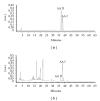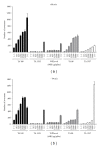In Vitro and In Vivo Genotoxicity Assessment of Aristolochia manshuriensis Kom
- PMID: 22844332
- PMCID: PMC3403598
- DOI: 10.1155/2012/412736
In Vitro and In Vivo Genotoxicity Assessment of Aristolochia manshuriensis Kom
Abstract
Arisolochiae species plants containing aristolochic acids I and II (AA I and AA II) are well known to cause aristolochic acid nephropathy (AAN). Recently, there are various approaches to use AAs-containing herbs after the removal of their toxic factors. However, there is little information about genotoxicity of Arisolochiae manshuriensis Kom. (AMK) per se. To obtain safety information for AMK, its genotoxicity was evaluated in accordance with OECD guideline. To evaluate genotoxicity of AMK, we tested bacterial reverse mutation assay, chromosomal aberration test, and micronucleus test. Here, we also determined the amounts of AA I and II in AMK (2.85 ± 0.08 and 0.50 ± 0.02 mg/g extract, resp.). In bacterial reverse mutation assay, AMK dose-dependently increased revertant colony numbers in TA98, TA100 and TA1537 regardless of metabolic activation. AMK increased the incidence of chromosomal aberration in Chinese hamster ovary-K1 cells, but there was no statistically significant difference. The incidences of micronucleus in bone marrow erythrocyte were significantly increased in mice after oral administration of AMK (5000 mg/kg), comparing with those of vehicle group (P < 0.05). The results of three standard tests suggest that the genotoxicity of AMK is directly related to the AAs contents in AMK.
Figures




Similar articles
-
Oral administration of Aristolochia manshuriensis Kom in rats induces tumors in multiple organs.J Ethnopharmacol. 2018 Oct 28;225:81-89. doi: 10.1016/j.jep.2018.07.001. Epub 2018 Jul 2. J Ethnopharmacol. 2018. PMID: 30008395
-
Isolation and purification of six aristolochic acids with similar structures from Aristolochia manshuriensis Kom stems by pH-zone-refining counter-current chromatography.J Chromatogr A. 2020 Feb 22;1613:460657. doi: 10.1016/j.chroma.2019.460657. Epub 2019 Oct 25. J Chromatogr A. 2020. PMID: 31685246
-
Aristolochia manshuriensis Kom inhibits adipocyte differentiation by regulation of ERK1/2 and Akt pathway.PLoS One. 2012;7(11):e49530. doi: 10.1371/journal.pone.0049530. Epub 2012 Nov 14. PLoS One. 2012. PMID: 23166699 Free PMC article.
-
Omeprazole Alleviates Aristolochia manshuriensis Kom-Induced Acute Nephrotoxicity.PLoS One. 2016 Oct 7;11(10):e0164215. doi: 10.1371/journal.pone.0164215. eCollection 2016. PLoS One. 2016. PMID: 27716846 Free PMC article.
-
Evaluation of in vitro and in vivo genotoxicity of Angelica acutiloba in a standard battery of assays.Lab Anim Res. 2017 Sep;33(3):231-236. doi: 10.5625/lar.2017.33.3.231. Epub 2017 Sep 27. Lab Anim Res. 2017. PMID: 29046698 Free PMC article.
Cited by
-
Contribution to the Preclinical Safety Assessment of Lannea velutina and Sorindeia juglandifolia Leaves.Plants (Basel). 2022 Dec 27;12(1):130. doi: 10.3390/plants12010130. Plants (Basel). 2022. PMID: 36616259 Free PMC article.
-
Acute Oral Toxicity and Genotoxicity of Polysaccharide Fraction from Young Barley Leaves (Hordeum vulgare L.).Foods. 2020 Jun 19;9(6):809. doi: 10.3390/foods9060809. Foods. 2020. PMID: 32575580 Free PMC article.
-
Genome-wide transcriptional analysis of Aristolochia manshuriensis induced gastric carcinoma.Pharm Biol. 2020 Dec;58(1):98-106. doi: 10.1080/13880209.2019.1710219. Pharm Biol. 2020. PMID: 31957525 Free PMC article.
-
Pro-inflammatory and toxicological evaluation of Hepacare® in mice.J Taibah Univ Med Sci. 2017 Mar 31;12(4):313-323. doi: 10.1016/j.jtumed.2017.02.004. eCollection 2017 Aug. J Taibah Univ Med Sci. 2017. PMID: 31435257 Free PMC article.
-
The growing use of herbal medicines: issues relating to adverse reactions and challenges in monitoring safety.Front Pharmacol. 2014 Jan 10;4:177. doi: 10.3389/fphar.2013.00177. eCollection 2014 Jan 10. Front Pharmacol. 2014. PMID: 24454289 Free PMC article. Review.
References
-
- Kupchan SM. Tumor inhibitors. I. Aristolochic acid, the active principle of aristolechia indica. Journal of Medicinal and Pharmaceutical Chemistry. 1962;5(3):657–659. - PubMed
-
- Moreno JJ. Effect of aristolochic acid on arachidonic acid cascade and in vivo models of inflammation. Immunopharmacology. 1993;26(1):1–9. - PubMed
-
- Cosyns JP. Aristolochic acid and ‘Chinese herbs nephropathy’: a review of the evidence to date. Drug Safety. 2003;26(1):33–48. - PubMed
-
- Shaohua Z, Ananda S, Ruxia Y, Liang R, Xiaorui C, Liang L. Fatal renal failure due to the Chinese herb ‘GuanMu Tong’ (Aristolochia manshuriensis): autopsy findings and review of literature. Forensic Science International. 2010;199(1-3):e5–e7. - PubMed
-
- The Chinese-English Medical Dictionary. Beijing, China: Renmin Weisheng; 2004.
LinkOut - more resources
Full Text Sources

